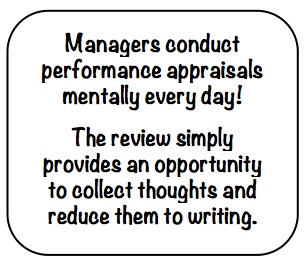Revitalizing Reviews
by Jean L. Seawright, CMC

There’s no question that employees are more effective when working in an environment that promotes regular communication about expectations and results. The reality is that people want to know where they stand—even if it isn’t good. A performance review is one important tool that can help address this need by answering the burning question every employee has: “How am I doing?”
Unfortunately, in many organizations, performance reviews have gone by the wayside, even though the younger generation of workers—the Millennials—are known for their need to receive regular feedback (and praise!) from management.
If your organization has bypassed reviews lately, it might be time to dust off the program or, better yet, reinvent the process to ensure a more effective evaluation experience. After all, the return on your investment of time is significant when you consider the benefits that come from implementing an effective review program. Chief among them are:
- The opportunity to develop employees and clarify expectations. Ultimately, high-performing employees make your life easier.
- Increased retention rates as a result of showing interest in the professional growth and development of employees.
- Improved performance when employees understand your expectations can specifically address deficiencies or capitalize on strengths.
- Enhanced communication between managers and employees.
- A consistent process for fairly evaluating employee performance.
- The basis for a pay increase (or not).
- HR infrastructure and a foundation to help grow the company.
- Documentation to help mitigate risk associated with employment decisions such as promotions, terminations, pay changes, and others.
Revamping the Review Process

Creating an effective performance evaluation program is one of the most important, though difficult, jobs a business can undertake. No other organizational system affects as many people as the performance evaluation does, nor affects them in such important ways. The performance evaluation system itself, combined with the way in which it is administered, affects how much money people will be paid, their relationship with their supervisor, their opportunities for promotion and professional growth, and their level of engagement with the organizational culture.
There is no set formula or principle that leads to the ‘best’ performance evaluation program. Organizations should consider how work gets done, the important accountabilities for each position or category of positions, supervisory skills related to evaluating employees, the compensation structure, technological capabilities, and the degree of simplicity or complexity desired. For example, will there be a goal-setting form? Employee self-evaluation forms? Automatic pay reviews? Evaluations administered after 90 days? Written guidelines for managers? Once these decisions are made, job-specific forms and a logical, fair process can be designed.
Pre-packaged software is an option; however, many of the programs are either too generic or available only as part of comprehensive HRIS systems that include a performance evaluation module among payroll, time and attendance, and HR recordkeeping programs. Nevertheless, this is certainly an option to explore.
Every company is unique. What is important is to find a system and implement a process that works for your organization!
Communicating Performance Standards Regardless of the system or process used, the effectiveness of any performance review depends on establishing meaningful performance standards that are specific to the position (or category of positions such as management, administrative, sales, and others) and communicating these to all employees upon hire. Surprising an employee with performance standards that were never communicated will, indeed, impact the employee—negatively! And it provides a perfect excuse for poor performance . . . “I had no idea this is what you were basing my performance on. If I had known, I would have . . .”
Regardless of the system or process used, the effectiveness of any performance review depends on establishing meaningful performance standards that are specific to the position (or category of positions such as management, administrative, sales, and others) and communicating these to all employees upon hire. Surprising an employee with performance standards that were never communicated will, indeed, impact the employee—negatively! And it provides a perfect excuse for poor performance . . . “I had no idea this is what you were basing my performance on. If I had known, I would have . . .” 
To avoid this scenario, along with the job description, show new hires your performance review form and continually communicate with the employee about performance throughout the year. If your workforce is comprised of Millennials, ongoing feedback is especially important! The younger generation is accustomed to being “plugged in” at all times, so waiting to discuss performance once a year can impact their morale. Speed and frequency of communication are essential. They also love praise—public, private, electronic, or written—any type of praise! So whenever employees exceed expectations, let them know.
Of course, if there are performance concerns, address them immediately and, when necessary, document them. Consider keeping a simple log (written or electronic) of performance conversations and issues for each employee so you can refer back to it when preparing the performance evaluation. This will make your job much easier when it’s time to prepare the evaluation and will help ensure that you do not focus only on recent events.
Suggestions for Effective Reviews
Overall, a performance review should be geared toward enhancing performance and helping the employee to grow professionally. You can conduct meaningful evaluations if you develop a sincere approach using diplomacy and tact, and if you are honest, straightforward, and fair. Here are some other important suggestions to help ensure your reviews are effective:
- Evaluate performance over the entire evaluation period. Recent employee incidents (positive or negative) often take on a “larger than life” role at review time. Managers can easily recall what happened last week or month, but may forget what happened nine months ago. Remember, your job is to evaluate performance over the entire evaluation period—not just the past few months. Think back over the entire period and look for patterns. Use specific examples from the entire time period.
- Beware of the “halo effect.” The halo effect takes place when you allow one positive characteristic of an individual to overshadow other more negative characteristics. Just because your employee is a great golfer (and so are you), doesn’t mean he or she can or will perform effectively on the job!
- Be frank and honest. If an employee is doing poorly, say so. Don't attempt to “sugar coat” the appraisal. This will cause more problems later on, especially in the event the employee is terminated for poor job performance that occurred during the time period covered by the review. If necessary, seek help to document problem areas. There are always ways to state performance problems in a dignified way by focusing on the employee’s behavior and specific workplace outcomes, not the character of the person.
- Avoid using language that creates a legal liability. Be careful not to promise future raises, continued employment, or a promotion. For example, using the phrase, “I know Bill will make the necessary changes and will have a long career with us” can send the message that future employment is being promised. Consider rewording such a phrase to something along the lines of, “Bill has expressed a desire to make the necessary changes in this review and to grow with the company.”
- Don’t send mixed messages. Employees who receive below-average scores on most or all individual performance criteria typically should not receive an overall satisfactory (or above) score! The only exception to this could be a situation where the evaluation is weighted and factors such as specific measurable goals that are outside of individual performance criteria scores carry a heavier weight and mathematically result in a satisfactory or above score.
- Take time with the employee. Make an effort to demonstrate that you are interested in the employee as an individual and that you consider the review to be extremely important. Prepare for the evaluation meeting and ensure your time with the employee is not rushed.
- Gain agreement from the employee. At the conclusion of the appraisal meeting, it is critically important to gain agreement from the employee that he or she will make any improvements or meet any outlined goals. If an employee does not agree to make certain changes, he or she is less likely to do so. Take the time to work through any areas of disagreement using specific examples.
- Ensure the employee signs and dates the form. Your performance evaluation form should include a signature block at the end with acknowledgement language such as, “I have read and reviewed this evaluation with my manager. I have had an opportunity to ask any questions and have had all my questions answered. I understand the importance of the feedback in this review and I agree to make any necessary changes as outlined in this form.”
- Follow up with employees after the evaluation on any open items. Remember to meet periodically with the employee to determine what progress he or she is making, particularly on areas or goals that were agreed upon.
If you’ve done your job all year long, you won’t dread conducting a performance appraisal. It really boils down to making time for your employees and learning how to communicate; two keys to any good relationship! Remember, your employees have a stake in the company. They can “make it” or “break it.” Review time is another opportunity to help them help you.
Jean Seawright, CMC
In addition, Seawright & Associates offers Group clients a unique one-on-one service arrangement to help meet additional human resource needs and challenges. For more information about Seawright & Associates visit www.seawright.com.
